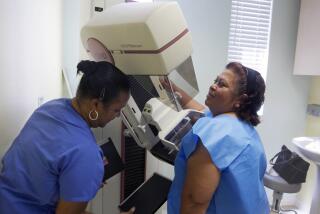Deadly cancer soars in women
Melanoma rates have risen 50% among young women in the U.S. since 1980, a trend that may be related to an increase in the use of tanning salons and exposure to the sun’s damaging rays, according to a report released Thursday.
Among young men, melanoma rates have remained steady, the study found.
The most lethal skin cancer, melanoma occurs in pigment-producing cells. The American Cancer Society estimates there will be 62,480 new cases of melanoma and 8,420 deaths from it in the U.S. this year.
Exposure to ultraviolet radiation is the biggest risk factor for developing the cancer, although genetic factors can also contribute. People with fair skin are most at risk, but melanoma occurs in people of all races and skin tones.
UV exposure comes from two main sources, said Dr. John Glaspy, a professor of medicine at the Jonsson Comprehensive Cancer Center at UCLA. “The first is worshiping the sun with our leisure time, and the other is tanning salons -- and that gets us to the subset of people that were involved in this study,” he said.
The report in the Journal of Investigative Dermatology analyzed more than 20,000 cases of melanoma in people between the ages of 15 and 39 that were reported to the Surveillance, Epidemiology and End Results (SEER) program, a large database maintained by the National Cancer Institute.
Researchers found that the incidence of melanoma in young women rose to 13.9 per 100,000 in 2004 from 9.4 per 100,000 in 1980. In young men, melanoma rates leveled off between 1980 and 2004, settling at 7.7 per 100,000 in 2004.
Researchers said that improved detection of early-stage cancer probably accounted for some of the increase in melanoma cases among young women but could not explain all of it.
Mark Purdue, a National Cancer Institute research fellow and the study’s lead author, said that researchers found comparable increases in the thin lesions characteristic of early-stage cancer and in thicker, later-stage melanomas.
“The fact that we see an increased incidence among thicker and later-stage melanomas suggests that this increase [in young women] is real and not simply the result of changes in surveillance,” Purdue said.
Researchers found some good news in the report. Overall deaths from melanoma in young adults decreased, a fact Purdue attributed to earlier detection of cancer, when the disease is in a more curable stage.
Purdue said people can reduce their general risk of developing melanoma by avoiding sun exposure when the sun’s rays are strongest, between 10 a.m. and 4 p.m.; wearing protective clothing and a sunscreen with an SPF of 15 or greater; and not actively seeking a tan in the sun or a salon.
--




